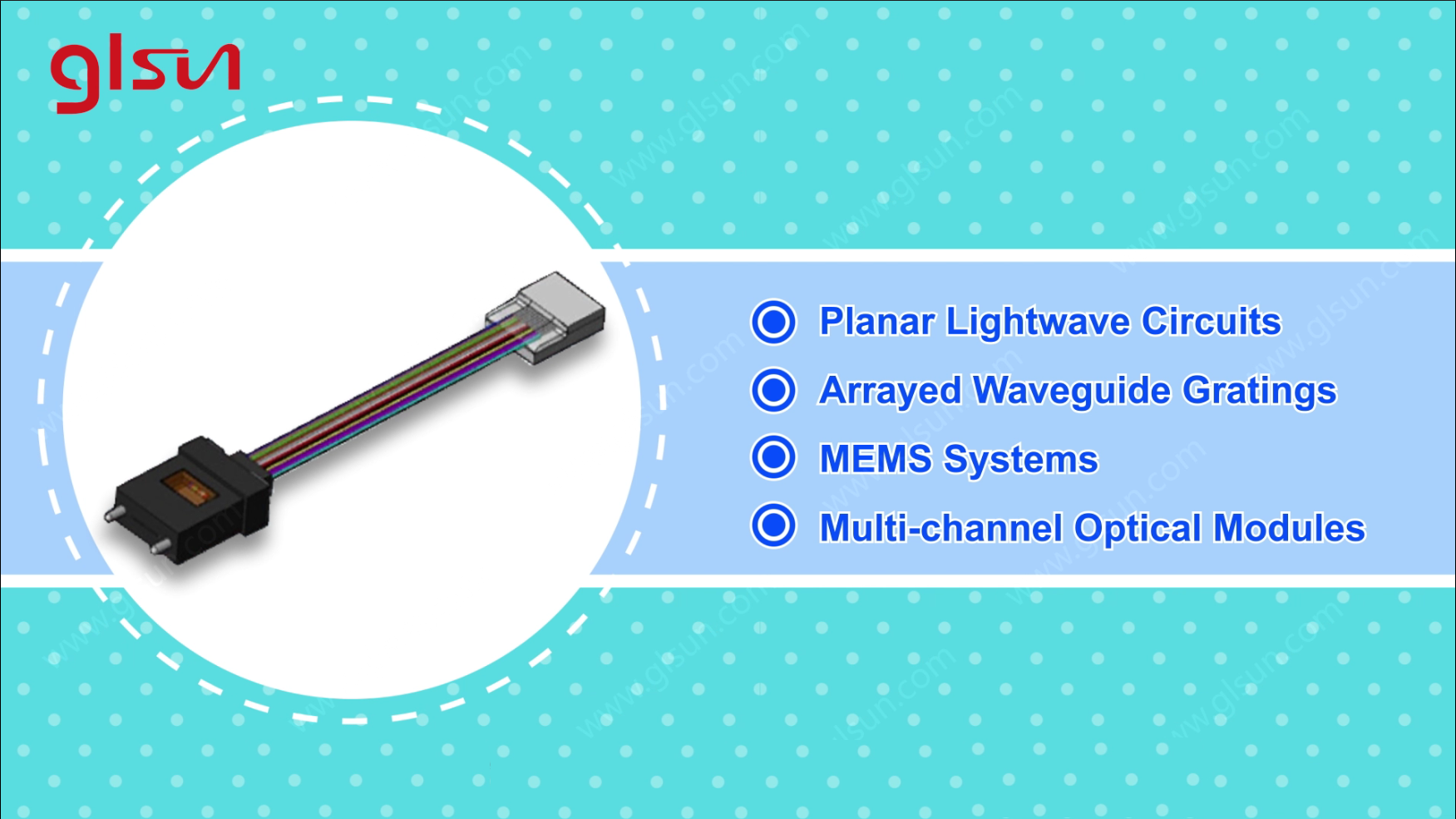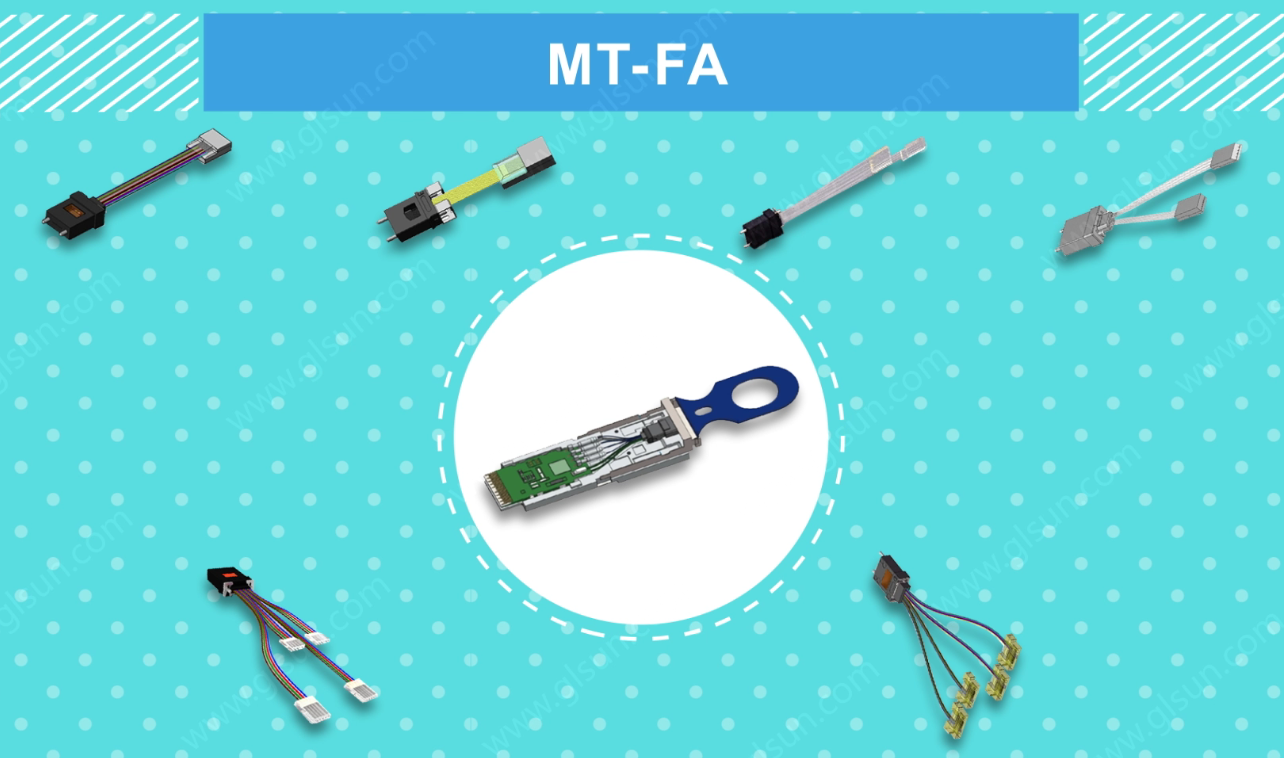Applications of Fiber Array (FA)
2025-04-30
Fiber arrays (FAs) have become foundational components in the evolution of integrated photonics and high-performance optical systems. By aligning multiple optical fibers with submicron precision, FAs enable dense, low-loss, and reliable optical connections between discrete components and photonic integrated circuits. Their compactness, repeatability, and compatibility with automated assembly processes make them essential in both active and passive photonic devices. This article explores the applications of fiber arrays in five critical domains: planar lightwave circuits (PLC), arrayed waveguide gratings (AWG), MEMS-based optical switches, multi-channel optical transceivers, and optical sensing systems.

Fiber Arrays in Planar Lightwave Circuits (PLC)
Planar lightwave circuits (PLC) are the backbone of passive optical components used in fiber-optic communication networks. Built on silica or silicon-based substrates, PLC devices use waveguides patterned in planar layers to route, split, or combine optical signals.
Typical applications include 1xN or NxN splitters, arrayed waveguide gratings, and other wavelength multiplexing or signal distribution devices. The performance of a PLC device is highly dependent on the efficiency and precision of light coupling at its input and output interfaces. Fiber arrays serve this critical role by aligning a linear row of fibers to match the waveguide pitch and position on the PLC chip. The entire assembly must maintain submicron accuracy in order to minimize coupling loss and ensure uniform transmission across all channels. The FA is typically mounted onto a V-groove array etched into silicon or glass, and then actively aligned with the PLC facet during packaging. Once aligned, the structure is fixed with epoxy or laser welding to ensure long-term mechanical stability and thermal resistance.
As network capacity requirements increase, PLC modules are scaling to support more channels, and the ability of fiber arrays to provide dense, repeatable optical interfaces becomes even more important. Their integration not only enhances the optical performance but also facilitates automated, cost-efficient mass production.
Fiber Arrays in Arrayed Waveguide Gratings (AWG)
Arrayed waveguide gratings (AWG) are vital components in dense wavelength division multiplexing (DWDM) systems, where multiple wavelengths of light must be precisely separated or combined. AWGs are fabricated with an array of waveguides of varying lengths, arranged to introduce specific phase delays that lead to constructive and destructive interference patterns, effectively dispersing or recombining light based on its wavelength.
To interface with AWG chips, fiber arrays are employed at both the input and output ends. The input FA injects multiplexed optical signals into the free propagation region (FPR), where they are distributed among the arrayed waveguides. After passing through the array, the dispersed light enters a second FPR and exits through the output FA, with each fiber capturing a distinct wavelength channel. This configuration enables high-channel-count modules with minimal crosstalk and low insertion loss. The success of the entire optical path depends on the alignment precision of the fiber arrays, as even slight deviations can result in spectral distortion or misalignment of wavelength channels. Therefore, the fabrication and packaging of AWG modules require FAs with tight pitch control, thermally matched materials, and long-term mechanical stability.
As optical networks push toward higher spectral efficiency, denser channel spacing, and larger channel counts (e.g., 48, 64, or 96 channels), the need for precision-engineered fiber arrays becomes even more pronounced. These FAs ensure that AWG modules can perform with the accuracy and reliability demanded by high-capacity optical transmission systems.
.png)
Fiber Arrays in MEMS Optical Systems
MEMS (Micro-Electro-Mechanical Systems) optical switches utilize miniature movable mirrors or actuators to dynamically route light beams between input and output ports, making them key components in reconfigurable optical add-drop multiplexers (ROADMs), data center interconnects, and optical cross-connects. In these systems, fiber arrays are used to direct optical signals to and from the MEMS switching matrix. Typically, one or more fiber arrays serve as input and output ports, mounted to face a micromirror array that redirects the optical beams along free-space paths. The alignment between the fiber arrays and MEMS mirrors must be exceptionally precise to maintain beam quality and minimize insertion loss. Furthermore, as the number of channels increases—reaching configurations like 32x32 or 64x64—fiber arrays must provide not only tight positional accuracy but also a compact footprint to fit within the confined space of the switch architecture. The structural stability of the FA also becomes critical in ensuring consistent alignment despite thermal expansion, vibration, or aging of the mechanical components.
Additionally, the planar arrangement of FAs simplifies optical packaging and allows for modular scalability, making it feasible to expand switching capacity without redesigning the entire system. As free-space MEMS switches become more widely deployed in large-scale optical networks, the fiber array continues to serve as the critical interface that combines precision optics with mechanical flexibility and high port density.
Fiber Arrays in Multi-Channel Optical Modules
With the relentless demand for faster data transmission in data centers and high-performance computing systems, multi-channel optical modules have become indispensable. Standards such as QSFP+, QSFP28, QSFP-DD, and OSFP support transmission rates from 100 Gbps to 800 Gbps and beyond, using parallel optical channels. Fiber arrays play an essential role in these modules by providing the optical coupling between the photonic transmitters/receivers and the external fiber ribbon cables.
In a typical transceiver, vertical-cavity surface-emitting lasers (VCSELs) or silicon photonics chips are aligned with a multi-core FA, often in MPO or MTP connector formats. The FA ensures that each optical signal path—representing a separate data lane—is precisely coupled, with low insertion loss and minimal crosstalk. This high-density interconnection allows for efficient parallel transmission, enabling compact module designs and reducing system footprint. Manufacturing such modules demands FAs with strict dimensional tolerances, especially for pitch, core height, and end-face quality. In automated production lines, FAs can be actively or passively aligned to the photonic elements, allowing for rapid assembly and high yield. Moreover, their compatibility with standardized connector types ensures plug-and-play interoperability across different systems.
As data center infrastructure evolves toward terabit-scale interconnects, fiber arrays will remain a key enabling technology, ensuring that optical modules deliver the required bandwidth, reliability, and scalability.

Fiber Arrays in Optical Sensing Systems
Beyond communication systems, fiber arrays also serve an important role in fiber-optic sensing technologies. These systems are deployed in a wide range of applications, including structural health monitoring, oil and gas exploration, aerospace systems, and biomedical diagnostics. Fiber-optic sensors such as fiber Bragg gratings (FBGs), interferometric sensors, and Fabry-Pérot cavities often require multiple sensing points that need to be interrogated simultaneously. Fiber arrays provide the ideal platform for such multi-point sensing by organizing multiple sensing fibers into a compact, manageable assembly. They allow a single interrogation system to send light through, and receive signals from, dozens or even hundreds of sensors distributed spatially across a structure. For example, in a bridge monitoring application, an FA can connect to a network of FBGs that respond to strain or temperature changes by reflecting specific wavelengths of light. The FA then collects these reflected signals and routes them to a spectrometer or demodulation unit. The mechanical robustness and repeatable alignment offered by fiber arrays make them especially suitable for use in harsh or dynamic environments. Furthermore, the compact nature of FAs facilitates their deployment in confined or embedded systems, such as within aircraft fuselages, wind turbine blades, or pipelines.
As real-time sensing becomes increasingly critical for infrastructure safety and predictive maintenance, the ability of fiber arrays to support dense, high-resolution, and distributed sensor networks positions them as essential components in the next generation of smart sensing systems.
Fiber arrays are no longer just passive components—they are enablers of optical precision, integration, and scalability across a wide range of applications. In photonic systems such as PLCs, AWGs, MEMS switches, high-speed transceivers, and distributed sensing networks, FAs deliver the critical optical alignment and stability necessary for performance and reliability. As photonic integration deepens and the complexity of optical systems grows, the importance of fiber arrays will continue to rise, making them a key technology in the ongoing evolution of optical communication and sensing.







